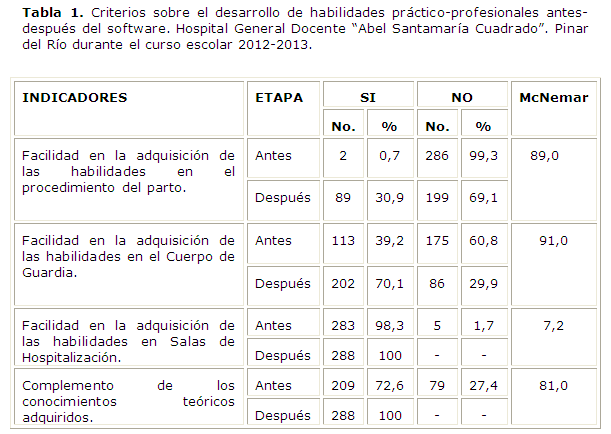Educative software for developing practical-professional skills in the subject Gynecology and Obstetrics
Keywords:
Information technology, Teaching, Software.Abstract
Introduction: The new information and communication technologies have a relevant significance in this new model of medical training.Objective: to validate educative software designed for developing practical-professional skills for the subject Gynecology and Obstetrics.
Material and methods: an observational and prospective research was carried out with undergraduate students of the Medicine, who in the first semester rotated by the subject Gynecology and Obstetrics at Abel Santamaría Cuadrado General Teaching Hospital of Pinar del Río, during the academic year 2012-2013. The sample was made up of 288 students from the fourth and sixth academic years of the major, who were interviewed before and after the software implementation.
Results: an educative software was designed made up of three fundamental parts including contents of Obstetrics, Gynecology and self-evaluation questions with their answers. Evaluation was performed before and after the software; all of the students manifested having understood the presented contents. Regarding the informatization of the subject, both students and professors coincide on the fact that it allows facilitation of the nearing process, is motivating and stimulating for studying, as a teaching aid, it helps understand the common practice of the specialty and communication among students and professors.
Conclusions: the designed software provides the students with continuous learning and self-evaluation with a useful methodological and didactic approach to reinforce theoretical and practical learning of the subject. Its creation constitutes a response to a real need fulfilled with the implementation of this teaching aid.
Downloads
References
1. Bunk GP. La transmisión de las competencias en la formación y perfeccionamiento profesionales de la RFA. Revista Europea de Formación Profesional[serie en Internet]. 1994[citado 10 Ene 2014]; 1: 8-14. Disponible en: http://dialnet.unirioja.es/servlet/articulo?codigo=131116
2. Cuba. VI Congreso del Partido Comunista de Cuba. Lineamientos de la Política Económica y Social. La Habana; 2010.
3. Alarcón Ortiz R. La calidad de la educación superior cubana: retos contemporáneos. Congreso Pedagogía 2013. Conferencia Inaugural. La Habana: Palacio de las Convenciones; 2013.
4. Willison J. Multiple contexts, multiple outcomes, one conceptual framework for research skill development in the undergraduate curriculum. Council on Undergraduate Research Quarterly. 2009; 29(3): 10-14. http://www.adelaide.edu.au/rsd/evidence/related-articles/willison_2009_CURQ_29_3_.pdf
5. Boyer E. The Boyer commission on educating undergraduates in the research university. Reinventing undergraduate education: A blueprintfor America's research universities. New York: Carnegie; Disponible en: http://www.niu.edu/engagedlearning/research/pdfs/Boyer_Report.pdf [Revisado el 28 de sept de 2012]
6. Cuba. Ministerio de Salud Pública. Plan de Estudios para la formación del Médico General. Modelo del profesional. La Habana: MINSAP; 2010.
7. Álvarez de Zayas C. Hacia una escuela por Excelencia. La Habana: Editorial Academia; 1996.
8. Montes de Oca Recio N, Machado Ramírez EF. Estrategias docentes y métodos de enseñanza-aprendizaje en la Educación Superior. Revista Humanidades Médicas[serie en Internet]. 2011[citado 10 Ene 2014]; 11(3). Disponible en: http://www.humanidadesmedicas.sld.cu/index.php/hm/article/view/127/81
9. Salinas J. Nuevos ambientes de aprendizaje para una sociedad de la información. Revista Pensamiento Educativo[serie en Internet]. 1997 [citado 10 Ene 2014]; 20: 81. Disponible en: http://www.ses.unam.mx/curso2008/pdf/Salinas.pdf
10. Salinas J. Redes y Educación: Tendencias en educación flexible y a distancia [monografía en internet]. Oviedo: 2000; Disponible en: http://tecnologiaedu.us.es/cuestionario/bibliovir/gte25.pdf [citado 10 Ene 2014]
11. Ávila Muñoz P. Consideraciones pedagógicas para la incorporación de la computadora como herramienta de apoyo al proceso educativo. Revista de Educación y Cultura[internet]. 2000[citado enero 2014]; 12: 9-10: Disponible en: http://www.latarea.com.mx/articu/articu12/pavila12.htm
12. Artiles Visbal L, Otero Iglesias J, Barrios Osuna I. Metodología de la Investigación para las ciencias de la salud. La Habana: Editorial Ciencias Médicas; 2008. Disponible en: http://www.bvs.sld.cu/libros_texto/metodologia_dela_investigacion_leticia/indice_p.htm
13. Barillas Arauz J. El Proceso de la Investigación científica. Guatemala: Facultad de Ciencias Médicas, Universidad de San Carlos de Guatemala; 2008.
14. Blanco Aspiazú MÁ, Menéndez Rivero L, Suárez Rivero B, Moreno Rodríguez MÁ, Bosch Bayard RI. Evaluación del uso de los estudios complementarios en el proceso diagnóstico. Educ Med Super[Internet]. 2006 Jun[citado 20 de enero de 2013]; 20(2). Disponible en: http://scielo.sld.cu/scielo.php?script=sci_arttext&pid=S0864-21412006000200002&lng=es
15. Agustín Vicedo T. La integración de conocimientos en la educación médica. Educ Med Super[Internet]. 2009 Dic [citado 5 Dic 2011]; 23(4):[aprox. 12 p.]. Disponible en: http://scielo.sld.cu/scielo.php?script=sci_arttext&pid=S0864-21412009000400008&lng=e

Published
How to Cite
Issue
Section
License
Authors who have publications with this journal agree to the following terms: Authors will retain their copyrights and grant the journal the right of first publication of their work, which will be publication of their work, which will be simultaneously subject to the Creative Commons Attribution License (CC-BY-NC 4.0) that allows third parties to share the work as long as its author and first publication in this journal are indicated.
Authors may adopt other non-exclusive license agreements for distribution of the published version of the work (e.g.: deposit it in an institutional telematic archive or publish it in a volume). Likewise, and according to the recommendations of the Medical Sciences Editorial (ECIMED), authors must declare in each article their contribution according to the CRediT taxonomy (contributor roles). This taxonomy includes 14 roles, which can be used to represent the tasks typically performed by contributors in scientific academic production. It should be consulted in monograph) whenever initial publication in this journal is indicated. Authors are allowed and encouraged to disseminate their work through the Internet (e.g., in institutional telematic archives or on their web page) before and during the submission process, which may produce interesting exchanges and increase citations of the published work. (See The effect of open access). https://casrai.org/credit/


